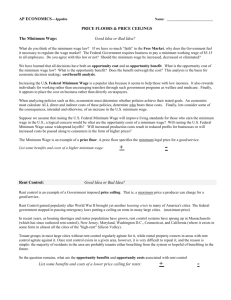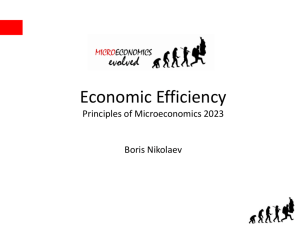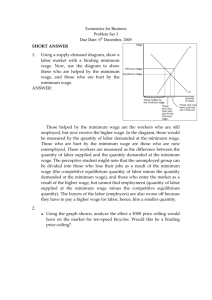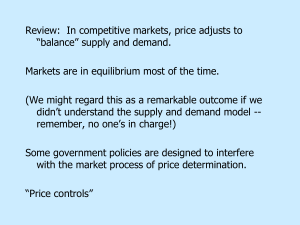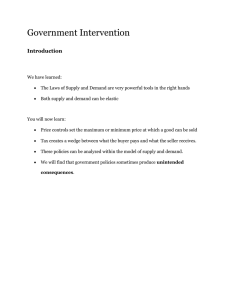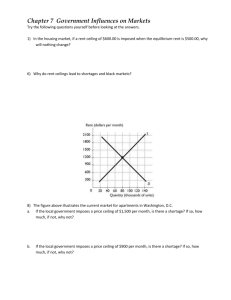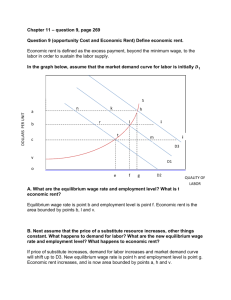04/16 - David Youngberg
advertisement
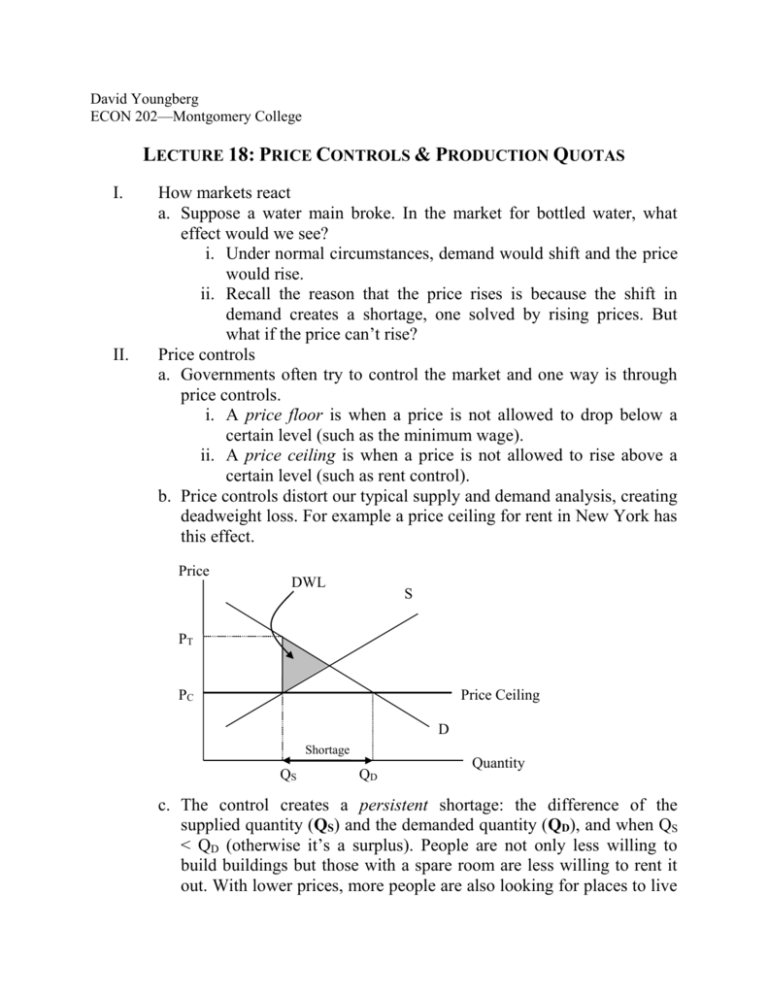
David Youngberg ECON 202—Montgomery College LECTURE 18: PRICE CONTROLS & PRODUCTION QUOTAS I. II. How markets react a. Suppose a water main broke. In the market for bottled water, what effect would we see? i. Under normal circumstances, demand would shift and the price would rise. ii. Recall the reason that the price rises is because the shift in demand creates a shortage, one solved by rising prices. But what if the price can’t rise? Price controls a. Governments often try to control the market and one way is through price controls. i. A price floor is when a price is not allowed to drop below a certain level (such as the minimum wage). ii. A price ceiling is when a price is not allowed to rise above a certain level (such as rent control). b. Price controls distort our typical supply and demand analysis, creating deadweight loss. For example a price ceiling for rent in New York has this effect. Price DWL S PT PC Price Ceiling D Shortage QS QD Quantity c. The control creates a persistent shortage: the difference of the supplied quantity (QS) and the demanded quantity (QD), and when QS < QD (otherwise it’s a surplus). People are not only less willing to build buildings but those with a spare room are less willing to rent it out. With lower prices, more people are also looking for places to live III. IV. (instead of living in a different borough or staying with a friend). This is one reason why it is so hard to find an apartment in Manhattan. d. The control creates deadweight loss. There are those who want to buy and sell above the control but are not allowed to. Both people walk away from the market unhappy and society as a whole is less wealthy. e. The control also creates a distinction between the true price (PT) and the price ceiling (PC), in other words what people legally pay and what they functionally pay. i. Examples of why the true price is higher are lines, bribes, search costs, etc. ii. The true price is sometimes called the black market price. f. Note that a price ceiling above the equilibrium price has no effect. It would be as if a law stated rent could not be greater than $8 million a month. Price Controls and Unintended consequences a. Generally price ceilings come about because people think a certain good should be cheaper (and thus easier) to buy. But as we see, for many people it actually makes it more difficult to buy because it creates a shortage. b. It also creates a distinction between the true price (PT) and the price ceiling (PC), where the true price actually exceeds what we would have seen without the control. c. This difference can manifest in many ways, and not always in a higher monetary price. It takes longer to find an apartment. You might have to pay a bribe to be considered for a place. Or to rent it. You might need to be friends with the right people. Landlords can more easily discriminate based on race, religion, gender, or age. d. These artificial costs are particularly hard to overcome, especially for the working poor and the elderly. e. Hence the perverse consequence of rent control: those that are supposed to be helped are those that are most harmed. The Market for Human Organs a. Because all organs, by law, must be donated (and not sold), it should not be surprising that there’s a tremendous scarcity for organs (even if we assume demand is inelastic). b. Not surprisingly, the true price manifests through personal connections or even the occasional under-the-table payment. Meanwhile, there are those willing to sell and buy organs (a practice which could save lives) but instead people die. V. The Minimum Wage a. There are many examples of price ceilings but very few of price floors (PF). However, the minimum wage is a prominent one. b. In the market for labor, employees are the supply curve and employers are the demand curve. Price DWL S PF Price Floor D Surplus QD VI. 1 QS Quantity c. Once again we see deadweight loss as those who wish to be hired at a lower wage cannot get employment even from those that would be willing to higher at that wage. d. Instead of a shortage, we see a surplus (also known as unemployment1). Lots of people want to work for the higher salary (perhaps they are looking for a second job, want to work longer hours, or want to stop being a stay-at-home parent). At the same time, fewer people wish to hire at that wage (perhaps they decided to produce less, close shop, or invest in automation). e. Again, the true price is different than the price floor (this is especially noticeable in other countries where the minimum wage and similar legislation makes hiring very expensive). It takes a long time to find a job. Personal contacts become more important. Firings become more likely. These are all costs the employee must bear. f. Once again, those that most need a higher wage (immigrants, the mentally handicap, and new adults) are the ones most likely not to get any wage at all: they have the hardest time justifying the higher wage. Quotas a. Production quotas are just like price controls except they set quantity rather than price. There are many reasons unemployment exists, some unavoidable and some not. The minimum wage is one of those avoidable reasons. b. Consider this minimum production quota, set above equilibrium. Price DWL S P D Quantity QMin i. Exactly what the price is depends on if it’s a production or consumption quota. We’ll focus on production quotas as they are more common. ii. In the above diagram, companies are required to over-produce. With so much in the market, the price, as determined by Demand, is lower than the market price. (If this was a consumption quota, the price would be higher, where the quota intersects Supply). c. Now consider this maximum production quota set below equilibrium. Price DWL S P D QMax Quantity i. With companies not allowed to produce more, prices rise (note the similarity between this and our monopoly model). d. Like price controls, production quotas can be completely ineffective. Maximum quotas set above equilibrium do nothing. Minimum quotas set below equilibrium do nothing.


